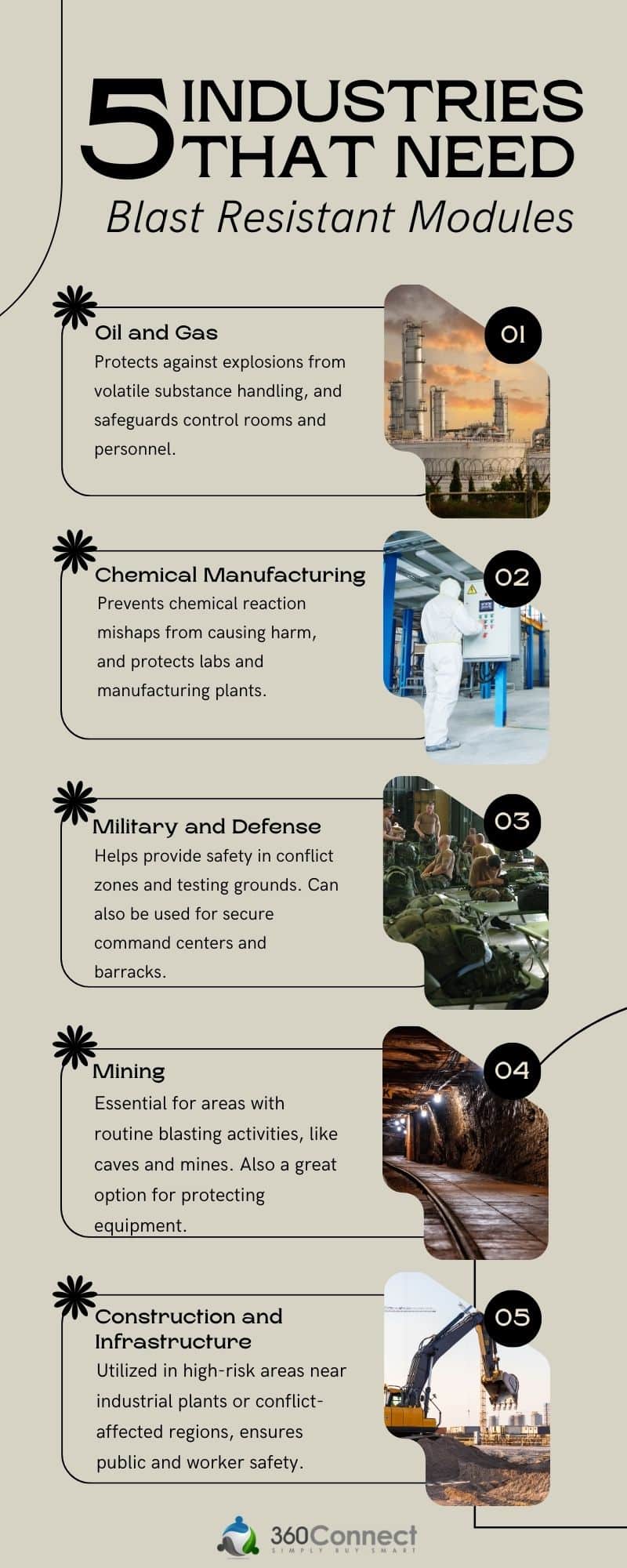Blast resistant modules (BRMs) are modular buildings that are constructed with higher-grade materials to better withstand blasts and explosions. These modular buildings are usually constructed with thick steel walls and special spacing mechanisms to help protect occupants. These buildings keep personnel safe when accidents happen on job sites. Having these structures on a job site is not just about mitigating risks; they help your team understand the need to prepare for any situation.
Understanding Blast Resistant Modules
There are no set federal regulations on what is decided as “blast resistant.” However, most providers follow the guidelines of the American Petroleum Institute in sections RP 752 and 753. This guidance gives both providers and customers measure to look for in blast resistant modular buildings.
Because there are no official guidelines, it’s extremely important to use a trusted partner that adheres to the standards suggested by the American Petroleum Institute. A trusted provider can supply you with reliable blast resistant modules that have been tested.
Common Use Cases for Blast Resistant Modules
You may be wondering, “What are some use cases for BRMs?” Their use cases vary across industries and can be implemented in a wide spectrum of jobs. Some of their use cases include, but are not limited to:
- Protected control rooms
- Temporary offices for industrial plants
- Laboratories
- Storage for volatile substances
- Barracks
- Command centers
Benefits of Blast Resistant Modules
Blast resistant modules are powerful office/storage solutions for companies, governments, and nonprofits to protect their employees. These specialized structures are critical to improving the overall safety and operation of job sites that are near explosions or dangerous materials.
Enhanced Protection Against Explosions and Blast
Let’s knock out the most obvious benefit. BRMs help protect your employees better than traditional temporary office solutions like mobile offices. These modules are engineered to absorb and deflect blast energy. They can dramatically reduce the danger of crew harm and vital equipment damage. While no building is explosion-proof, blast resistant modules give your team the best chance if things do go wrong.
Future Flexibility and Movement
BRMs are modular, meaning they can be moved/stacked with relative ease. This is especially important for businesses that move from job site to job site. Additionally, this allows companies to be able to use the modular building how they see fit between different jobs. On one site it can be outfitted to be a break room for employees, and on another job site, it can be used as storage space for tools/materials.
Reduced Liability
Implementing BRMs as part of a comprehensive safety policy can help a corporation decrease its responsibility in the case of an accident. While this is not a guarantee and is dependent on the accident, having the right office equipment can help your case. Moreover, this is a good investment to build trust with employees and instill that you value them and their safety. If a BRM helps protect one life, it will be worth it.
Protection from Daily Industrial Noises
One overlooked but often important benefit of BRMs is the ability to better insulate the space from outside noise. Modules made from these materials have significant sound insulation, which results in a more comfortable, quieter workspace. Reduced noise pollution contributes to a safer work environment, as well as employee health and productivity by reducing stress-related illnesses and hearing damage.

How to Choose a Blast Resistant Module
Because there is no set official guideline to go off, choosing a high-quality supplier is critical to finding a quality BRM. You’ll want to look for a provider that follows the guidelines established by the American Petroleum Institute. You’ll also want a blast-resistant module that has a medium-low response level.
Response levels
BRMs are categorized based on their response levels to blasts: low, medium, and high. These levels correspond to the module’s ability to withstand certain blast pressures and impacts. The higher the response level, the more damage is going to happen to that BRM.
Low Response: Explosion damage is relatively little or minor and the building is still usable. Repairs may be needed for the structure or integrity of the modular building. These repairs should be relatively moderate/minor.
Medium Response: Major damage to the structure and integrity of the building. The building cannot be used and needs repairs before use again.
High Response: Critical failure in the structure’s integrity. The building will need lengthy and costly repairs that are similar to buying a new structure entirely.
What is Modular Construction?
Learn MoreCustom vs. Pre-engineered Options
When searching for BRMs, you have two main options for finding the right solution for you.
Custom: A more expensive option, custom BRMs are designed and built to meet specific requirements. However, you’ll have flexibility in layout, response level, features, electrical needs, and more.
Pre-engineered: This is a more cost-effective solution that has a pre-planned layout and features and can be implemented with relative ease. These solutions are built in standard sizes and have shorter implementation times than custom blast resistant modules. You can usually choose from a range of features and designs to meet your needs. Whether that be an office space or a laboratory.
You’ll want to also consider specific features like:
- Electrical hookups
- HVAC setups
- Office space setups
- Wi-fi setups
- Plumbing
- And others
Need a Blast Resistant Module?
Are you considering a BRM for your job site? Don’t worry, 360Connect can help you find that modular building from a high-quality supplier. Just fill out our 1–2-minute form and we’ll contact you to verify your information and needs. From there, you can receive up to 5 quotes from suppliers for free. It’s that simple!

